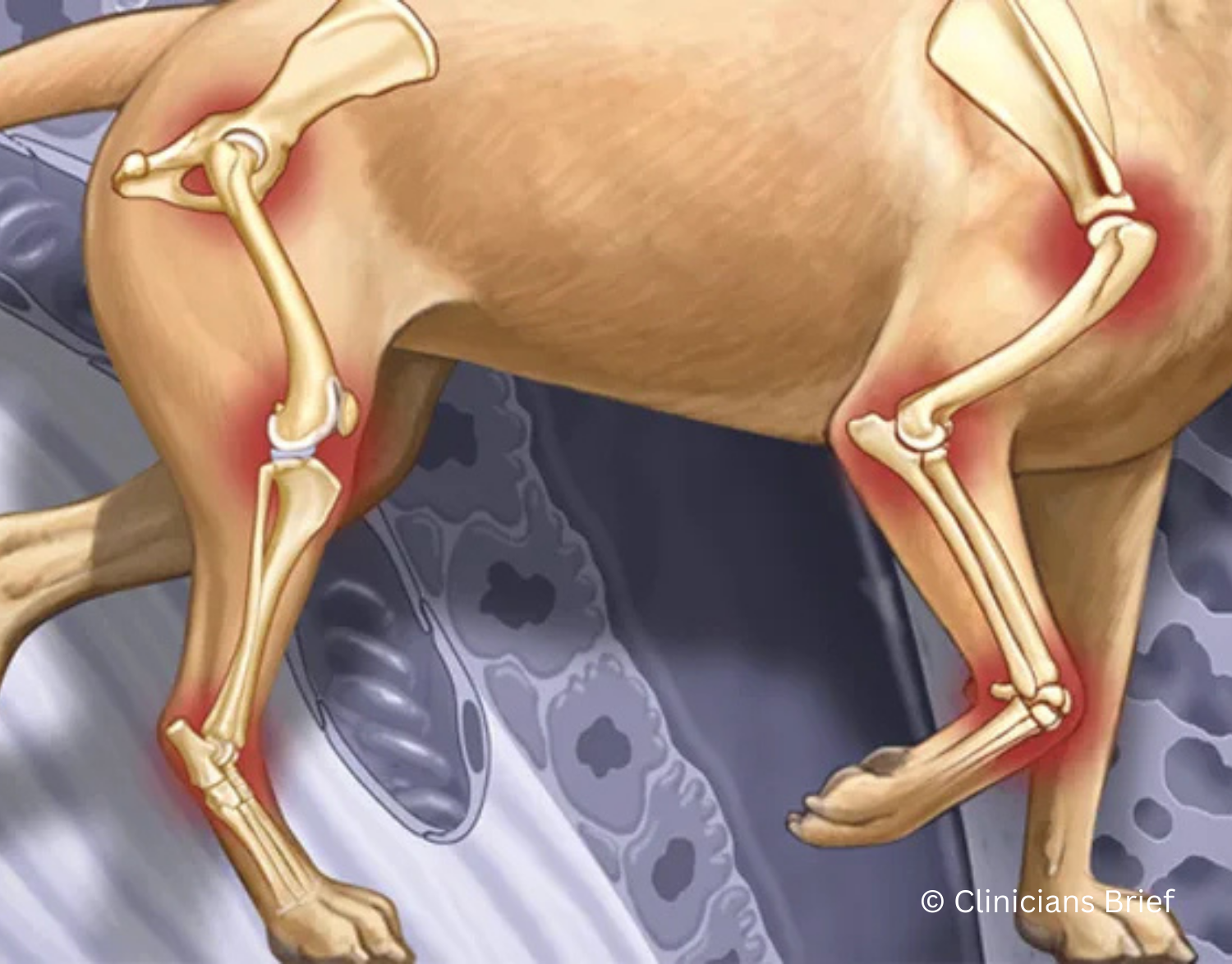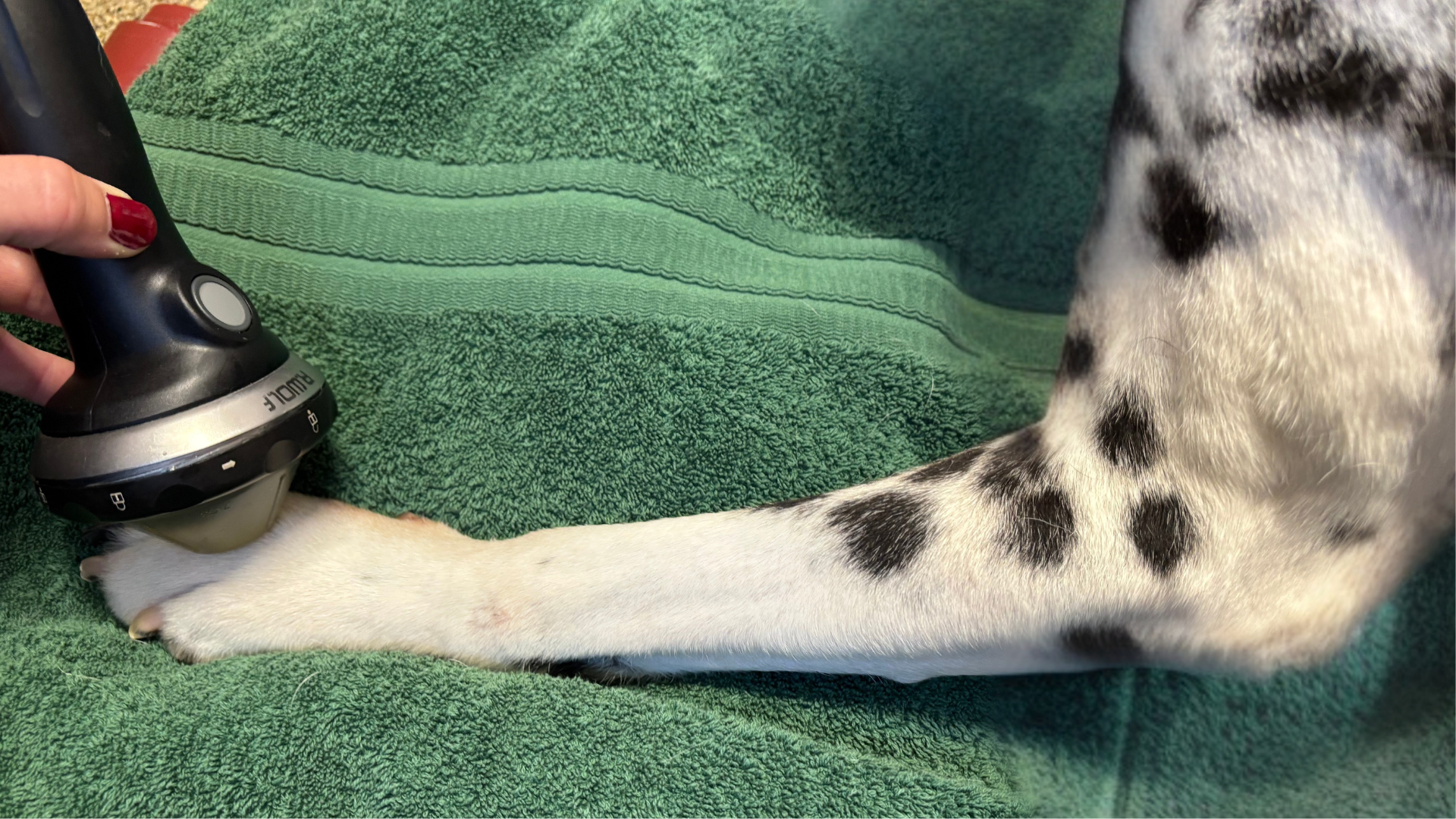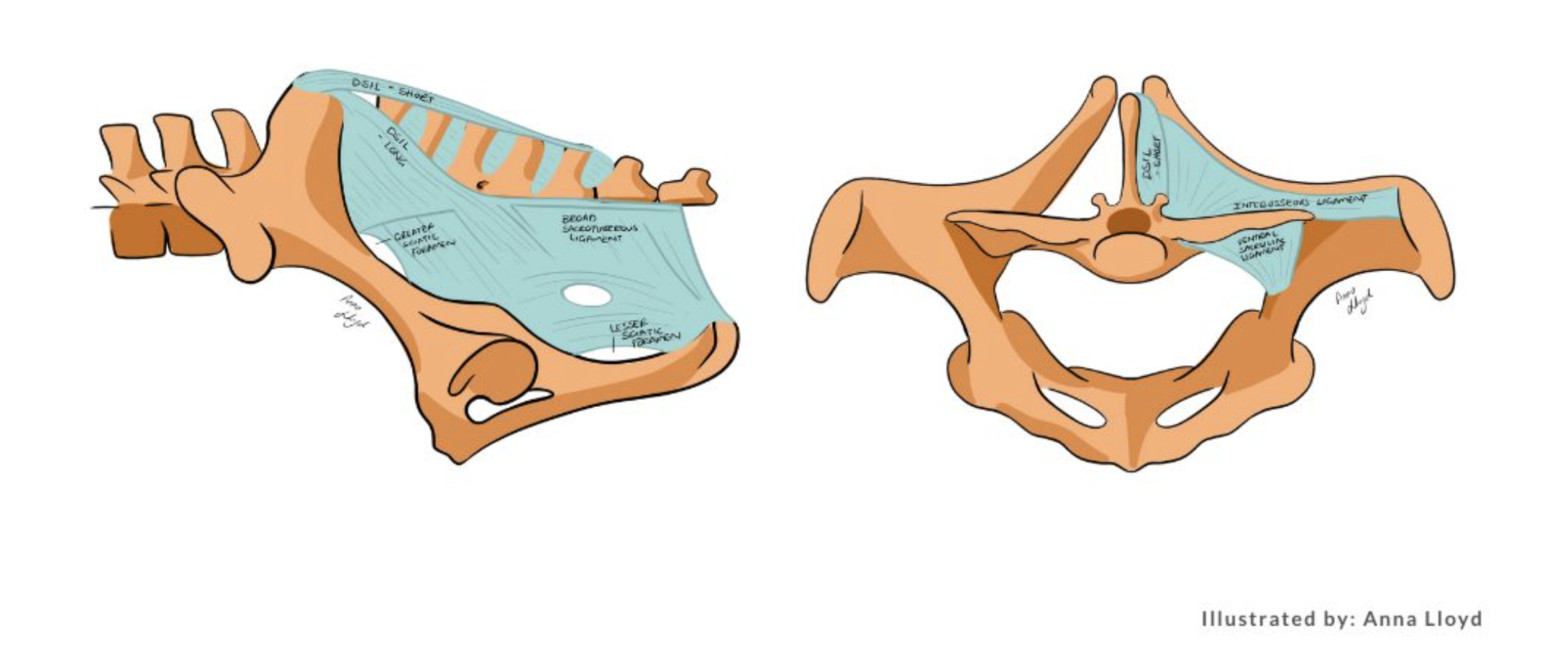Osteoarthritis, the Disease and Treatment Benefits of Focused Shockwave
Osteoarthritis (OA) is a progressive degenerative joint disease affecting 20-40% of small animal patients. The progression rate varies among patients and can be influenced by diet, genetics, age, breed, and environment1. OA often occurs secondary to other common conditions in veterinary medicine, such as cruciate disease, elbow dysplasia, hip dysplasia, intervertebral disc disease (IVVD), and obesity. It limits mobility and daily activities, impacting the pet's quality of life. While there is no cure for OA, early detection is crucial, and a multimodal approach to physiotherapy can slow the disease's progression 2.
The progression of osteoarthritis can be summarized in the four stages below 3: 1. Development of small bone spurs and initial cartilage degradation, leading to joint inflammation and pain.
1. Development of small bone spurs and initial cartilage degradation, leading to joint inflammation and pain.
2. Cartilage lesions cause erosion of subchondral bone. Osteophytes and bone spurs affect joint movement, and fragments of collagen and proteoglycan appear in the synovial fluid.
3. Loss of cartilage depth between bones results in the grinding of adjacent subchondral bone surfaces. The synovial fluid produces secondary messengers that can destroy tissue and stimulate cartilage repair. Inflammation and pain often become severe at this stage.
4. The joint space becomes minimal with little to no cartilage present, significantly inhibiting joint mobility.
Educating pet owners and early detection are vital to reducing the number of domestic animals suffering from severe OA. Various treatment plans are available for OA 4. Currently, a wide range of nutraceuticals, pharmacologics, and joint injections are beneficial for OA treatment 5,6,7. Rehabilitation practitioners and physiotherapists specialize in creating a multimodal plan that includes therapeutic modalities like PEMF, laser, and shockwave therapy. This approach, along with early detection, offers pet owners the chance to minimize pain, inflammation, and joint degradation caused by OA.
Substantial scientific evidence supports the use of focused shockwave therapy for OA treatment. Numerous studies in rat and rabbit OA models demonstrate that shockwave therapy slows cartilage damage progression by reducing; nitric oxide levels, metalloproteinase concentrations, proteoglycan loss, and chondrocyte apoptosis 8,9,10. These studies also indicate that shockwave therapy enhances; subchondral bone repair, type II collagen synthesis, cartilage proliferation, and blood flow to the subchondral bone 9,10. Published studies also highlight the positive effects of focused shockwave therapy on canine elbow and stifle OA, as well as induced OA in the middle carpal joint of horses 6,11,12.
The PiezoWave2T Vet shockwave is ideal for treating joints with OA. Its focal zone specificity and depth of penetration allow practitioners to target different tissues within the arthritic joint based on patient needs without affecting surrounding healthy tissue. This results in minimal post-treatment pain. For example, in senior animals with severe joint OA and significant cartilage and bone remodeling, treating the synovium for anti-inflammatory effects and pain control is crucial. Conversely, if OA is detected early, before bone and cartilage damage, PiezoWave 2T Vet shockwave treatment can target the synovium, subchondral bone, and cartilage at various depths and angles. The PiezoWave 2T shockwave's energy settings enable treatment without sedation and in a stress-free environment. An initial series of 3-6 treatments, depending on the case, can dramatically improve an animal's mobility. However, since disease progression can only be slowed, patients may return for PiezoWave treatment as needed or on a maintenance schedule. Maintenance therapy varies by case but can significantly enhance a senior pet's quality of life.
References:
- Fox, S. M. (2016). Multimodal management for canine osteoarthritis. In Multimodal Management of Canine Osteoarthritis (pp. 41-102). CRC Press.
- Mille, M. A., McClement, J., & Lauer, S. (2022). Physiotherapeutic strategies and their current evidence for canine osteoarthritis. Veterinary sciences, 10(1), 2.
- Bland, S. D. (2015). Canine osteoarthritis and treatments: a review. Veterinary Science Development, 5(2).
- Loeser, R. F., Goldring, S. R., Scanzello, C. R., & Goldring, M. B. (2012). Osteoarthritis: a disease of the joint as an organ. Arthritis and rheumatism, 64(6), 1697.
- Grubb, T. (2023). Select drugs and compounds for canine osteoarthritis management. Today’s Veterinary Practice, 36-41.
- Shaw, K. K. (2020). From cells to steroids: what should we inject into joints?.
- Frisbie, D. D., Kawcak, C. E., & McIlwraith, C. W. (2009). Evaluation of the effect of extracorporeal shock wave treatment on experimentally induced osteoarthritis in middle carpal joints of horses. American journal of veterinary research, 70(4), 449-454.
- 9. Zhao, Z., Ji, H., Jing, R., Liu, C., Wang, M., Zhai, L., ... & Xing, G. (2012). Extracorporeal shock-wave therapy reduces progression of knee osteoarthritis in rabbits by reducing nitric oxide level and chondrocyte apoptosis. Archives of orthopaedic and trauma surgery, 132, 1547-1553.
- 10. Wang, C. J., Cheng, J. H., Chou, W. Y., Hsu, S. L., Chen, J. H., & Huang, C. Y. (2017). Changes of articular cartilage and subchondral bone after extracorporeal shockwave therapy in osteoarthritis of the knee. International journal of medical sciences, 14(3), 213.
- 11. Wang, C. J., Hsu, S. L., Weng, L. H., Sun, Y. C., & Wang, F. S. (2013). Extracorporeal shockwave therapy shows a number of treatment related chondroprotective effect in osteoarthritis of the knee in rats. BMC Musculoskeletal Disorders, 14, 1-8.
- 12. Dahlberg, J., Fitch, G., Evans, R. B., McClure, S. R., & Conzemius, M. (2005). The evaluation of extracorporeal shockwave therapy in naturally occurring osteoarthritis of the stifle joint in dogs. Veterinary and Comparative Orthopaedics and Traumatology, 18(03), 147-152.
- 13. Millis, D., Drum, M., & Whitlock, D. (2011). Complementary use of extracorporeal shock wave therapy on elbow osteoarthritis in dogs. Vet Comp Orthop Traumatol, 24(3), A1.
ELvation Marketing Team
Combining sales and flexible customer support with many years’ in-depth knowledge of medical equipment we offer customized solutions to create value with long-term investments and medical supplies. ELvation’s strength lies in its ability to combine the apparently contradictory needs of improving the standards of patient care by providing high-quality medical technology and good corporate profitability. We have a special partnership with Richard Wolf GmbH as their long-term authorized Sales & Service Team for piezo shockwave systems.



